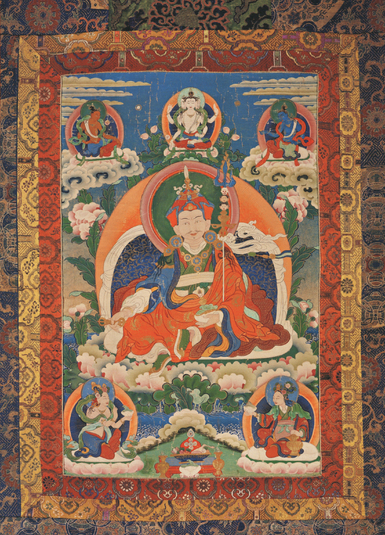
Item: Padmasambhava - (Main Form)
| Origin Location | Tibet |
|---|---|
| Date Range | 1900 - 1959 |
| Lineages | Buddhist |
| Material | Ground Mineral Pigment on Cotton |
| Collection | Private |
Guru Rinpoche Padmasambhava (Tibetan: pe ma jung ne, English: Lotus Born): regarded as one of the three principal founders of Buddhism in Tibet.
With a steady composure gazing on all beings, white in colour with a pinkish hue, one face adorned with a moustache and goatee, the right hand holds atop the knee a gold vajra scepter. The left hand placed in the lap holds a white skullcup filled with nectar, jewels and a long-life vase. The ornate katvanga staff of a Vajrayana mendicant decorated with white streamers rests against the left shoulder. Adorned with gold earrings and a necklace, the head is covered with a lotus hat, a gift of the King of Zahor, of silk brocade topped with a half-vajra and a single vulture feather. Attired in various robes of different colours reflecting the disciplines of the Vinaya, Bodhisattva and Mantra Vehicles, he sits atop a moon disc above a multi-coloured lotus blossom rising from the blue waters of Dhanakosha lake.
Seated to the viewer's left is the consort Mandarava holding the long-life symbols of an arrow with a mirror and streamers in the right hand and a vase in the left. At the viewer's right is the consort Yeshe Tsogyal holding up a skull offering bowl with the left hand.
"Miraculous buddha arising from a lotus, unborn, undying, possessing a vajra body, performing the activity of all buddhas of the three times; homage to Padmasambhava." (Nyingma liturgical verse).
At the top center is Amoghapasha Lokeshvara, white in colour, with three faces and four hands. Seated to the right and left are an orange and blue peaceful figure, likely to represent orange Manjushri and blue Vajrapani - forming the group known as the Three Lords of the World.
Along with Trisong Detsen and Shantarakshita, Padmasambhava is considered one of the principal early teachers to bring Buddhism to Tibet in the 8th century, Padmasambhava has numerous forms representing outer, inner and secret aspects of his spiritual being. He is also known by many different names which generally follow chronologically his life story. Aside from Trisong Detsen and Shantarakshita, the most important figures to interact with Padmasambhava were his principle Tibetan consort Yeshe Tsogyal and the principal Twenty-five Disciples. There are various Padmasambhava Number Sets which help to organize the important topics and essential subjects of his life and chronological sequence of important events, along with grouping the various sub-sets of important disciples. An 18th century curiosity is the inclusion of Padmasambhava as one of the pre-incarnations in the line of Panchen Lamas.
Jeff Watt 4-2022
Collection of the National Museum of Asian Art (Atelier Series)
Padmasambhava Main Page
Collection of the National Museum of Asian Art (Shrine)
Padmasambhava: Main Form (Vajra at the Knee)
